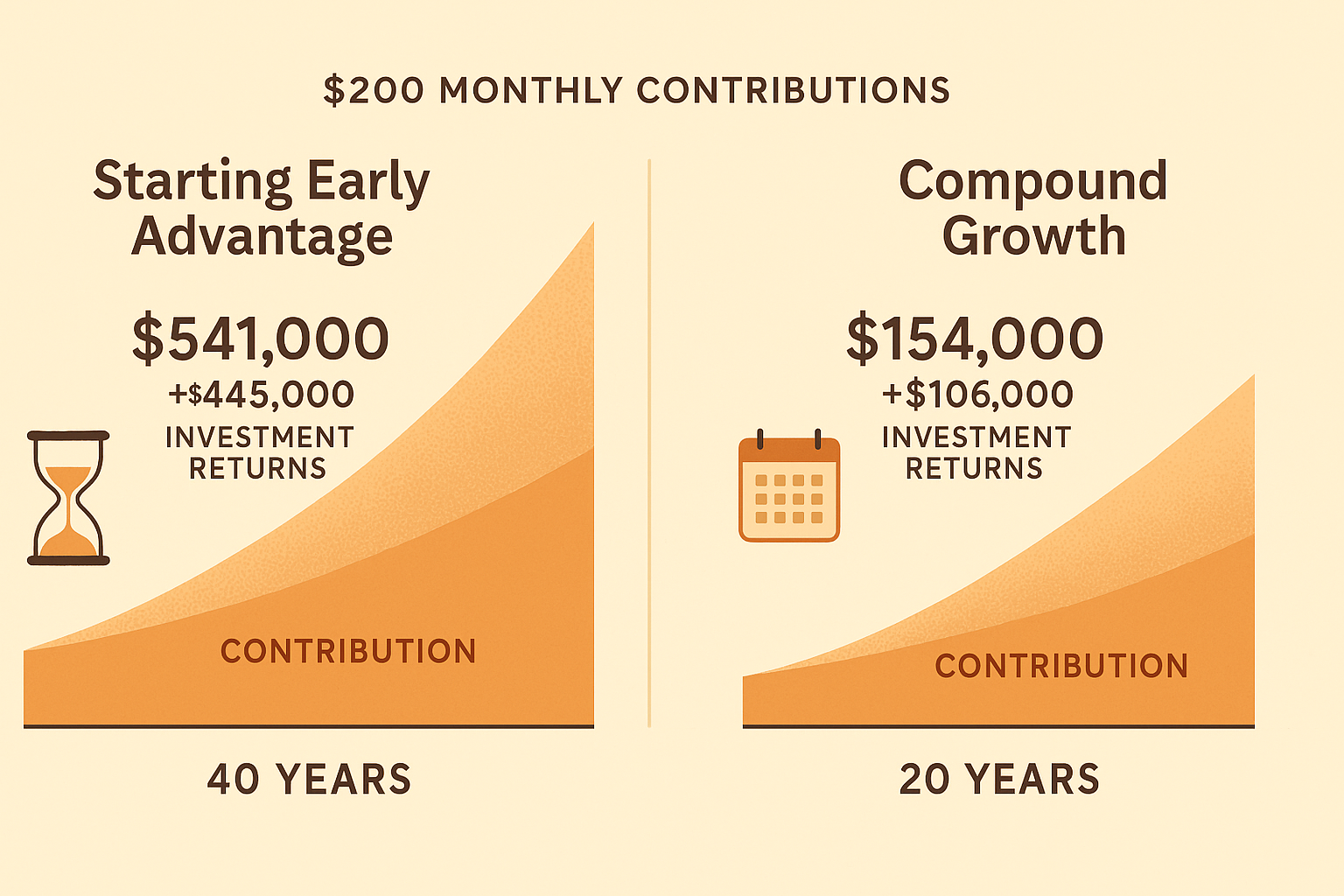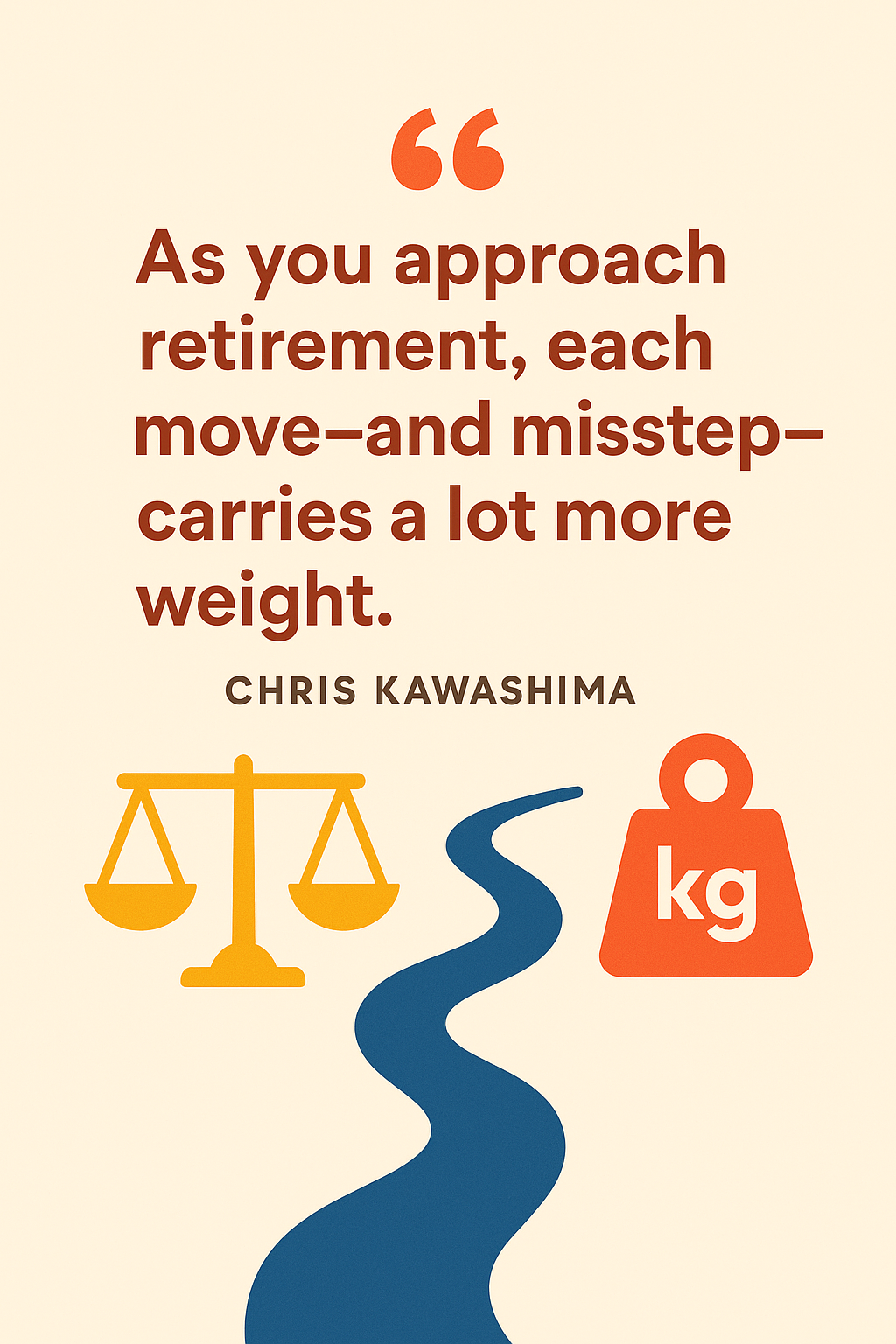The Truth About Building Retirement Wealth
The best way to invest for retirement is to:
- Start early – Even small amounts benefit from decades of compound growth
- Max out tax-advantaged accounts – Contribute to 401(k)s (especially with employer match) and IRAs
- Diversify with low-cost index funds – Maintain an appropriate stock/bond mix based on your age
- Automate contributions – Set up regular deposits to ensure consistent investing
- Adjust strategy as you age – Gradually shift from growth to income as retirement approaches
The best way to invest for retirement isn’t about finding a magical investment that will make you rich overnight. It’s about consistent, disciplined saving combined with smart investment choices that match your timeline and risk tolerance.
Financial security in retirement doesn’t just happen. According to research, 57 percent of working Americans say they’re behind on retirement savings. This doesn’t have to be you.
The five years before and after retirement are among the most important—and potentially vulnerable—for your savings. With the average retirement lasting approximately 20 years (and many people living into their 90s), your money needs to work hard for decades.
As Chris Kawashima notes, “As you approach retirement, each move—and misstep—carries a lot more weight.” This is why having a clear strategy matters.
Social Security will typically only replace about 40% of your pre-retirement income if you earn less than $100,000 annually. The rest needs to come from your investments.
The good news? You have time on your side. Starting early allows the power of compound interest to work its magic—even small contributions can grow substantially over decades.

Understanding Your Retirement Goals
Before we dive into investment strategies, let’s take a moment to think about what you’re actually saving for. After all, retirement planning isn’t just about accumulating a pile of money—it’s about funding the life you want to live when you’re no longer working.
Estimating Your Retirement Expenses
Have you ever wondered how much money you’ll actually need in retirement? Most financial experts suggest aiming for about 70-90% of your pre-retirement income to maintain your lifestyle.
Why not 100%? Well, some expenses naturally decrease in retirement. You’ll no longer have commuting costs, work clothes to buy, or (hopefully) a mortgage payment. However, other expenses might increase—especially healthcare and leisure activities.
When I talk with clients at Finances 4You, I encourage them to consider:
Your dream retirement lifestyle. Will you be traveling the world or enjoying quiet time at home? Those European river cruises cost a lot more than gardening and reading!
Healthcare needs. This is the big one that catches many people by surprise. A 65-year-old couple today might need as much as $383,000 just for healthcare expenses throughout retirement. Yes, you read that right.
Housing situation. Will your mortgage be paid off? Are you planning to downsize or perhaps move to that beachfront condo you’ve always wanted?
Family responsibilities. Many retirees find themselves helping adult children or caring for aging parents, which can significantly impact your financial needs.
Take some time to really visualize your retirement. The clearer your vision, the better you can plan for it.
Life Expectancy Considerations
Here’s something to celebrate: we’re living longer than ever! The average American who reaches 65 today will live to about 85. But averages can be misleading—about one in three 65-year-olds will live past 90, and one in seven will live beyond 95.
What does this mean for your retirement planning? Simply put, your money might need to last 30 years or more. At Finances 4You, we typically recommend planning for at least a 30-year retirement. It’s far better to have money left over than to run out while you still have years of life ahead.
Inflation Risk
Inflation is like a silent thief that gradually steals your purchasing power. Even with moderate inflation of 2.6% annually (the historical average), the cost of living could double in about 25 years.
Let me put that in perspective: if you need $50,000 for your annual expenses today, you might need close to $100,000 annually 25 years from now—just to buy the same groceries, pay the same bills, and enjoy the same activities.
This is why the best way to invest for retirement isn’t just about saving—it’s about growing your money at a rate that stays ahead of inflation. Your retirement dollars need to work as hard as you did during your career!
When you’re creating your retirement plan, don’t just think about the dollar amount you’ll need in year one. Think about what you’ll need in years 10, 20, and even 30 of your retirement. This long-term perspective will help ensure you don’t outlive your savings.
Best Ways to Invest for Retirement

Finding the best way to invest for retirement isn’t about chasing hot stocks or timing the market. It’s about creating a thoughtful strategy that works with your timeline and comfort level. Think of it as planning a decades-long journey – you need the right vehicle, good navigation, and enough fuel to reach your destination.
Maximize Tax-Advantaged Accounts: The Best Way to Invest for Retirement
If there’s a “secret sauce” to retirement success, tax-advantaged accounts are definitely it. These special accounts help your money grow faster by reducing the tax drag on your investments.
401(k) Plans
Your employer’s 401(k) plan should be your first stop on the retirement savings train, especially if there’s a match. That employer match? It’s literally free money waiting for you to claim it.
If your employer matches 50% of your contributions up to 6% of your salary, you’re getting an immediate 50% return before your investments even do anything. That’s like finding a 50% off coupon for your retirement!
Traditional 401(k) contributions come out of your paycheck before taxes, reducing your taxable income now. Roth 401(k) options, meanwhile, let your money grow completely tax-free. In 2024, you can sock away up to $23,500 in your 401(k), with an extra $7,500 if you’re 50 or older.
As Rob Haworth, senior investment strategy director, puts it: “People are realizing that they can reduce volatility in their portfolio while generating more competitive income in today’s interest rate environment.”
IRAs (Individual Retirement Accounts)
Think of IRAs as the more flexible cousins of 401(k)s. They offer similar tax advantages but let you choose from a much wider range of investments.
With a Traditional IRA, you might get a tax deduction now, and your money grows tax-deferred until retirement. You’ll start taking Required Minimum Distributions at age 73.
A Roth IRA works differently – you pay taxes on the money now, but then it grows completely tax-free, and qualified withdrawals in retirement won’t cost you a penny in taxes. As financial expert David Littell notes, “The Roth election makes sense if you expect your tax rate to be higher at retirement than it is at the time you’re making the contribution.”
For 2024, you can contribute up to $7,000 to either type of IRA ($8,000 if you’re 50+). For the latest contribution limits and rules, check the IRS retirement plans page.
Self-employed? Don’t worry – you have options too, like SEP IRAs, SIMPLE IRAs, and Solo 401(k)s, which often allow for even higher contribution limits.
At Finances 4You, we’ve seen that clients who maximize these tax-advantaged accounts typically end up with 15-25% more retirement wealth than those who don’t – even when they’re saving the same amount! That’s the power of tax-efficiency at work.
Diversify Your Portfolio: Another Best Way to Invest for Retirement
Diversification isn’t just financial jargon – it’s your safety net. Spreading your investments across different types of assets helps smooth out the bumpy ride of market volatility.
Asset Allocation Basics
Your asset allocation – how you divide your money between stocks, bonds, and other investments – should reflect both your time horizon and comfort with risk. You’ve probably heard the old rule of thumb: subtract your age from 100 to find your ideal stock percentage. But with people living longer, many experts now recommend using 110 or even 120 as the starting number.
A 40-year-old might aim for 70-80% in stocks, while someone in their 60s might dial that back to 50-60%. The key is having enough growth potential to outpace inflation over time.
Stocks provide growth potential and inflation protection. They’re your portfolio’s engine, helping your savings outpace rising costs over decades. Bonds act as shock absorbers, providing income and stability when markets get rough. Alternative investments like REITs can add another layer of diversification.
Our research found that a $2 million portfolio with 60% stocks and 40% bonds could potentially still be worth nearly $854,000 after 30 years of retirement withdrawals. The same portfolio with only 20% in stocks? It would likely run dry by year 29. That’s why maintaining some growth exposure matters, even in retirement.
For more information on how diversification can protect your investments, visit the SEC’s Investor.gov resource on diversification.
The Power of Low-Cost Index Funds
For most people, low-cost index funds represent the best way to invest for retirement. They’re like the Swiss Army knife of investing – simple, effective, and remarkably versatile.
Index funds offer broad diversification at rock-bottom costs (often under 0.1% annually). They’re tax-efficient and require minimal maintenance. Even Warren Buffett – one of history’s greatest investors – has advised that most people should simply invest regularly in an S&P 500 index fund.
When you consider that many actively managed funds charge 1% or more annually and still fail to beat their benchmarks, the case for index funds becomes even stronger. That 1% difference might not seem like much, but over decades, it could easily translate to tens or even hundreds of thousands of dollars.
Consider Professional Financial Advice

DIY investing works well for many people, but sometimes a professional perspective can make all the difference – especially as your financial life becomes more complex.
You might consider working with a financial advisor if you’re approaching retirement (within 5-10 years), have a complex situation involving business ownership or inheritance, or simply want the peace of mind that comes with professional guidance.
Today’s options range from traditional financial advisors (offering comprehensive, personalized advice) to robo-advisors (providing algorithm-based portfolio management at lower costs) to hybrid models that combine technology with human expertise.
At Finances 4You, we believe the right approach depends on your unique circumstances, comfort with technology, and the complexity of your financial situation. Sometimes, having an objective third party can help you avoid emotional decisions and stay the course when markets get turbulent.
The best way to invest for retirement isn’t about finding some magical shortcut – it’s about creating a solid plan, making consistent contributions, keeping costs low, and staying disciplined through market ups and downs. Your future self will thank you for the effort!
Strategies for a Secure Retirement

Having a nest egg is wonderful, but knowing how to use it wisely throughout your retirement years? That’s where the real magic happens. Let’s talk about turning your savings into a reliable income stream that lasts as long as you do.
Create a Retirement Income Plan
When you’ve spent decades saving, the shift to spending can feel like driving on the opposite side of the road – technically possible but a bit nerve-wracking at first. Here are four approaches to generating retirement income that our clients have found success with:
Income annuities offer something precious in retirement: certainty. Like having a personal pension, they provide guaranteed income for life, eliminating the worry of outliving your money. Martha, a Finances 4You client, tells us her annuity gives her “permission to enjoy life without constantly checking my portfolio.” The downside? You sacrifice some flexibility and liquidity, and fixed payments can lose purchasing power to inflation over time.
Diversified bond portfolios create a steady stream of interest payments while preserving your principal. They’re like the reliable friend who always shows up when needed. Bonds provide more flexibility than annuities, allowing you to adjust as your needs change. However, they’re sensitive to interest rate fluctuations and typically offer lower returns than stocks over the long haul.
The total return approach involves systematically withdrawing from a diversified portfolio of stocks and bonds. This strategy balances growth potential with income needs. You may have heard of the famous “4% rule” – withdrawing 4% of your portfolio in the first year of retirement, then adjusting for inflation thereafter. Today, many experts suggest a more flexible 3-5% withdrawal rate based on market conditions and your personal situation.
Income-producing equities like dividend-paying stocks can provide both income and growth. Companies with long histories of increasing dividends – think Johnson & Johnson or Coca-Cola – can help your income keep pace with inflation. During a recent client workshop, we compared two retirement portfolios over a 20-year period. The one including quality dividend stocks maintained purchasing power 37% better than the all-bond portfolio.
Most successful retirees don’t rely on just one approach. They create a blended strategy that provides both security and growth potential. As one client put it, “I sleep well knowing my essential expenses are covered by guaranteed income, while my growth investments give me a chance at the extras.”
Protect Your Savings from Inflation and Market Volatility
Inflation and market volatility are like termites and storms threatening your retirement home – invisible dangers that require proactive protection.
Inflation silently erodes your purchasing power year after year. At just 3% inflation, your money loses half its buying power in 24 years. That’s why the best way to invest for retirement includes specific inflation-fighting tools:
Treasury Inflation-Protected Securities (TIPS) automatically adjust with inflation, providing a government-backed safety net. I Bonds offer similar protection with some tax advantages. Dividend growth stocks from companies with pricing power tend to increase payouts faster than inflation. Real estate investments – whether through direct ownership, REITs, or funds – historically keep pace with or exceed inflation.
Market volatility, meanwhile, poses the greatest threat during your early retirement years. A significant market drop right after you retire can permanently damage your portfolio’s longevity. This “sequence of returns risk” is why we recommend these protective strategies:
Build a cash buffer of 1-2 years of expenses. This prevents forced selling during market downturns – the financial equivalent of an emergency fund for your retirement. James, who retired in 2008, credits his two-year cash reserve with “saving my retirement” during the financial crisis.
Regular portfolio rebalancing maintains your desired risk level and can actually improve returns. When you rebalance, you’re essentially selling high and buying low – a winning strategy in any market.
The bucket strategy divides your portfolio into time horizons: immediate needs (cash), medium-term needs (bonds and stable investments), and long-term growth (stocks). This approach provides peace of mind knowing your near-term expenses aren’t subject to market whims.
At Finances 4You, we’ve seen the dramatic difference these protective strategies make. Two clients with identical starting portfolios experienced drastically different outcomes based solely on liquidity management. The client without short-term reserves, who was forced to sell investments during downturns, depleted their portfolio in just 18 years. The client with proper liquidity planning extended their portfolio’s life by three additional years – potentially the difference between a comfortable retirement and financial stress.
Retirement isn’t just about accumulating wealth – it’s about creating sustainable income that lasts as long as you do. With thoughtful planning and the right strategies, you can build a retirement that’s not just financially secure, but truly fulfilling.
Common Mistakes to Avoid When Investing for Retirement
Let’s be honest—even when you know the best way to invest for retirement, it’s still easy to stumble. After helping hundreds of clients at Finances 4You, we’ve seen these common pitfalls trip up even the most diligent savers. Here’s how to avoid them:
Starting Too Late
The single most expensive retirement mistake is simply waiting too long to begin. The magic of compound interest means that even small early contributions dramatically outperform larger late ones.
Consider our favorite example of George and Jane:
George starts investing a modest $200 monthly at age 25, while Jane waits until age 30 to begin the exact same $200 monthly investment. By retirement at 65, assuming an 8% annual return, George accumulates over $310,000 while Jane reaches only $206,000. That five-year head start—just 60 extra contributions—creates more than $100,000 in additional retirement wealth!
This isn’t about making anyone feel bad for a late start. It’s about recognizing that today is always the best day to begin, regardless of your age. The second-best day is tomorrow.
Neglecting Employer Matches
I still wince when clients tell me they’re not capturing their full employer match. This isn’t just missing an opportunity—it’s literally declining free money that could transform your retirement.
If you earn $60,000 annually with an employer that matches 50% of contributions up to 6% of your salary, contributing the full 6% ($3,600) nets you an additional $1,800 annually from your employer. That’s a guaranteed 50% return before your money even touches the market! Contributing only 3% means you’re leaving $900 on the table each year—which could compound to over $300,000 over a 30-year career.
Lifestyle Creep
As your career advances and income grows, it’s natural to want nicer things. The new car, the bigger home, the fancier vacations—all wonderful if you can truly afford them. But many forget to increase their retirement contributions alongside their lifestyle upgrades.
As financial advisor Susan Hirshman bluntly puts it: “Every dollar not saved in peak earning years might lead to hard choices later.”
At Finances 4You, we recommend automatically directing a percentage of every raise toward retirement before you ever see it in your checking account. You’ll still enjoy lifestyle improvements while keeping retirement on track.
Being Too Conservative Too Soon
The pendulum swings both ways when it comes to risk. While young investors are often too conservative (keeping too much in cash), pre-retirees sometimes make the opposite mistake—becoming too conservative too quickly.
Our research consistently shows that maintaining at least 50% in stocks during early retirement years significantly extends portfolio longevity. A portfolio that’s too conservative might feel safe, but actually increases your risk of outliving your money as inflation erodes your purchasing power.
This doesn’t mean gambling with your retirement security. It means thoughtfully balancing growth and stability based on your specific timeline and needs.
Failing to Plan for Healthcare Costs
Many retirees are shocked by healthcare expenses. A 2022 report estimates a 65-year-old couple might need a staggering $383,000 just for healthcare during retirement.
Medicare doesn’t cover everything, and long-term care costs can be catastrophic without proper planning. At Finances 4You, we typically recommend clients consider long-term care insurance before age 65 or maximize Health Savings Account (HSA) contributions if eligible—these accounts offer triple tax advantages while specifically addressing healthcare needs.

The stakes get higher as retirement approaches. Small adjustments early in your career can be corrected over time, but missteps in the years just before or after retirement can permanently alter your financial security.
Frequently Asked Questions about the Best Way to Invest for Retirement
How Much Should I Save for Retirement?
The classic advice is to save 15% of your gross income for retirement, including what your employer chips in. But let’s be real – this isn’t one-size-fits-all.
If you started saving in your 40s instead of your 20s, you’ll likely need to sock away more than 15%. If you dream of traveling the world in retirement rather than puttering around your paid-off home, your number might be closer to 20%. And if you’re planning to work until 70 instead of retiring at 62, you might get away with saving less each year.
I like to think of retirement savings milestones as mile markers on a highway. They help you know if you’re making good time:
- By age 30: Have about 1x your annual salary saved
- By age 40: About 3x your salary
- By age 50: About 6x your salary
- By age 60: About 8x your salary
- By age 67: About 10x your salary
Don’t panic if you’re behind – many people are! At Finances 4You, we help clients understand where they stand compared to others in their age group and create realistic plans to catch up.
When Should I Start Investing for Retirement?
Yesterday would have been perfect. Today is the next best option.
The magic of compound interest means that time is literally money. A 25-year-old who invests $200 monthly until age 65 can end up with over $100,000 more than someone who starts just five years later at age 30, even though the actual difference in contributions is only $12,000.
As Debra Greenberg, director of Retirement and Personal Wealth Solutions, puts it: “The earlier you can get started, the better off you’ll be.”
If you’re just starting your career, focus first on getting that employer match – it’s free money! Then gradually ramp up your contributions as your salary grows. Already in your 40s or 50s? Don’t worry – the best way to invest for retirement at any age is to start now. Take advantage of those catch-up contributions the IRS allows once you hit 50, and consider talking to a financial advisor about an accelerated plan.
It’s never too late to improve your financial future. Even small changes today can make a meaningful difference tomorrow.
What’s the Best Retirement Account for Me?
The “best” account depends on your unique situation – your employment status, tax bracket, and financial goals all play important roles.
If you work for a company offering a 401(k) match, that’s your first stop – contribute at least enough to get the full match. It’s essentially an immediate return on your investment that you won’t find anywhere else. After securing that match, consider whether a Roth or Traditional IRA makes sense before maxing out your 401(k).
Self-employed? You have some great options too. A Solo 401(k) offers high contribution limits if you’re a one-person show. A SEP IRA might make more sense if you have employees or want something simpler to administer. And SIMPLE IRAs are perfect for small businesses with fewer than 100 employees.
Your tax situation should guide your Roth versus Traditional decision. The best way to invest for retirement tax-wise depends on a simple question: Do you expect to be in a higher tax bracket now or in retirement? If you think your tax rate will be higher in retirement, Roth accounts (where you pay taxes now but get tax-free withdrawals later) might be your best bet. If you expect to drop to a lower tax bracket in retirement, traditional pre-tax accounts could save you money in the long run.
At Finances 4You, we dig into our clients’ current tax situations and future projections to recommend the perfect mix of accounts. Sometimes the answer isn’t either/or – it’s both, creating tax diversification that gives you flexibility in retirement.
Conclusion
The best way to invest for retirement isn’t a one-size-fits-all formula—it’s a personalized journey that evolves as you do. At its core, successful retirement planning combines early and consistent saving with thoughtful investment choices that match your unique timeline and comfort with risk.
Think of your retirement strategy as a living document rather than something you set and forget. Life happens—careers change, families grow, and priorities shift. Your retirement plan should adapt alongside these changes while keeping your long-term goals in focus.
Pay special attention to what financial experts call the “dangerous decade”—the five years before and after you retire. This critical period can make or break your financial security. Having enough cash on hand to weather market downturns, maintaining the right mix of investments, and knowing exactly how you’ll withdraw your money can spell the difference between peaceful golden years and constant financial worry.
It’s never too early to start—or too late to improve your approach. Whether you’re just beginning your career with decades ahead or you’re counting down the years to retirement, the fundamental principles remain unchanged: save consistently, invest wisely, and plan thoughtfully. By embracing these guidelines, you can build retirement confidence without sacrificing sleep.

Here at Finances 4You, we’re passionate about helping you build a retirement strategy that feels right for your unique situation. We understand that comparing your progress to others in your age group can provide valuable perspective—but your retirement journey is uniquely yours. Our goal is to provide the guidance, tools and encouragement you need to create not just financial security, but genuine peace of mind.
The best retirement plan is one that you can stick with through market ups and downs, one that grows with you as your life evolves, and one that ultimately helps you create the future you envision. Start today—even with small steps—because your future self deserves the gift of financial freedom.





2 thoughts on “How to Invest for Retirement Without Losing Sleep”
Pingback: Retirement Planning 101: Simple Steps to Secure Your Future - Finances 4 You
Pingback: The Ultimate Guide to Retirement Savings Plans - Finances 4 You
Comments are closed.